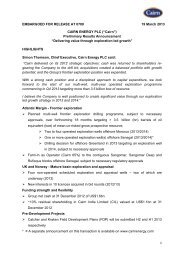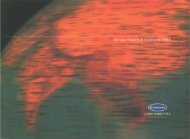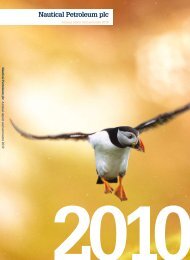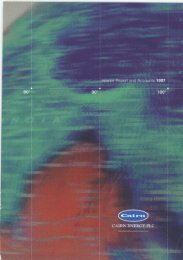Annual Report 2007 in PDF - Cairn Energy PLC
Annual Report 2007 in PDF - Cairn Energy PLC
Annual Report 2007 in PDF - Cairn Energy PLC
Create successful ePaper yourself
Turn your PDF publications into a flip-book with our unique Google optimized e-Paper software.
NOTES TO THE ACCOUNTS<br />
CONTINUED<br />
1. Account<strong>in</strong>g Policies (cont<strong>in</strong>ued)<br />
(j) Investments<br />
The Company’s <strong>in</strong>vestments <strong>in</strong> subsidiaries are carried at cost less provisions result<strong>in</strong>g from impairment. The recoverable value<br />
of <strong>in</strong>vestments is the higher of its fair value less costs to sell and value <strong>in</strong> use. Value <strong>in</strong> use is based on the discounted future net<br />
cash flows of the oil and gas assets held by the subsidiary.<br />
Discounted future net cash flows for IAS 36 purposes are calculated us<strong>in</strong>g an estimated oil price of $60/bbl (2006: $30/bbl) or<br />
the appropriate gas price as dictated by the relevant gas sales contract, escalation for prices and costs of 3%, and a discount<br />
rate of 10% (2006: 3% and 10% respectively). Forecasted production profiles are determ<strong>in</strong>ed on an asset by asset basis, us<strong>in</strong>g<br />
appropriate petroleum eng<strong>in</strong>eer<strong>in</strong>g techniques.<br />
(k) Inventory<br />
Inventories of oil and condensate held at the Balance Sheet date are valued at net realisable value based on the estimated<br />
sell<strong>in</strong>g price <strong>in</strong> accordance with established <strong>in</strong>dustry practice.<br />
(l) F<strong>in</strong>ancial <strong>in</strong>struments<br />
A f<strong>in</strong>ancial <strong>in</strong>strument is any contract that gives rise to a f<strong>in</strong>ancial asset of one entity and a f<strong>in</strong>ancial liability or equity <strong>in</strong>strument<br />
of another entity.<br />
F<strong>in</strong>ancial assets are categorised as f<strong>in</strong>ancial assets held at fair value through profit or loss, held-to-maturity <strong>in</strong>vestments,<br />
loans and receivables and available-for-sale f<strong>in</strong>ancial assets. The Group holds f<strong>in</strong>ancial assets which are classified as either<br />
available-for-sale f<strong>in</strong>ancial assets or loans and receivables, with the exception of derivative f<strong>in</strong>ancial <strong>in</strong>struments which are<br />
held at fair value through profit or loss.<br />
F<strong>in</strong>ancial liabilities generally substantiate claims for repayment <strong>in</strong> cash or with another f<strong>in</strong>ancial asset. F<strong>in</strong>ancial liabilities are<br />
categorised as either fair value through profit or loss or held at amortised cost. All of the Group’s f<strong>in</strong>ancial liabilities are held at<br />
amortised cost, with the exception of derivative f<strong>in</strong>ancial <strong>in</strong>struments which are held at fair value through profit or loss.<br />
F<strong>in</strong>ancial <strong>in</strong>struments are generally recognised as soon as the Group becomes party to the contractual regulations of the<br />
f<strong>in</strong>ancial <strong>in</strong>strument.<br />
Derivative f<strong>in</strong>ancial <strong>in</strong>struments<br />
The Group uses derivative f<strong>in</strong>ancial <strong>in</strong>struments such as foreign currency options to hedge its risks associated with foreign<br />
currency fluctuations. Such derivative f<strong>in</strong>ancial <strong>in</strong>struments are designated upon <strong>in</strong>itial recognition as at fair value through profit<br />
or loss. The derivative f<strong>in</strong>ancial <strong>in</strong>struments are <strong>in</strong>itially recognised at fair value on the date on which a derivative contract is<br />
entered <strong>in</strong>to and are subsequently remeasured at fair value. Derivatives are carried as assets when the fair value is positive<br />
and as liabilities when the fair value is negative.<br />
Any ga<strong>in</strong>s or losses aris<strong>in</strong>g from changes <strong>in</strong> fair value on derivatives dur<strong>in</strong>g the year are taken directly to the Income Statement.<br />
The Group did not apply hedge account<strong>in</strong>g for derivative f<strong>in</strong>ancial <strong>in</strong>struments held dur<strong>in</strong>g the current or prior year.<br />
Available-for-sale f<strong>in</strong>ancial assets<br />
Available-for-sale f<strong>in</strong>ancial assets are those non-derivative f<strong>in</strong>ancial assets that are not classified as loans and receivables. The<br />
Group’s available-for-sale f<strong>in</strong>ancial assets represent listed equity shares which are held at fair value (the quoted market price).<br />
Movements <strong>in</strong> the fair value dur<strong>in</strong>g the year are recognised directly <strong>in</strong> equity and are disclosed <strong>in</strong> the Statement of Recognised<br />
Income and Expense. The cumulative ga<strong>in</strong> or loss that arises on subsequent disposal of available for sale f<strong>in</strong>ancial assets will be<br />
recycled through the Income Statement.<br />
Loans and other receivables<br />
Trade receivables, loans and other receivables that have fixed or determ<strong>in</strong>able payments that are not quoted on an active<br />
market are classified as ‘loans and receivables’. Loans and receivables are measured at amortised cost us<strong>in</strong>g the effective <strong>in</strong>terest<br />
method less any impairment. Trade and other receivables are recognised when <strong>in</strong>voiced. Interest <strong>in</strong>come is recognised by<br />
apply<strong>in</strong>g the effective <strong>in</strong>terest rate, except for short-term receivables where the recognition of <strong>in</strong>terest would be immaterial.<br />
The carry<strong>in</strong>g amounts of loans and other receivables are tested at each report<strong>in</strong>g date to determ<strong>in</strong>e whether there is objective<br />
material evidence of impairment, for example, overdue trade debt. Any impairment losses are recognised through the use<br />
of an allowance account. When a trade receivable is uncollectible, it is written off aga<strong>in</strong>st the allowance account. Subsequent<br />
recoveries of amounts previously written off are credited aga<strong>in</strong>st the allowance account. Changes <strong>in</strong> the carry<strong>in</strong>g amount of<br />
the allowance account are recognised <strong>in</strong> the Income Statement or the Balance Sheet <strong>in</strong> accordance with where the orig<strong>in</strong>al<br />
receivable was recognised.<br />
Bank deposits<br />
Bank deposits with an orig<strong>in</strong>al maturity of over three months are held as a separate category of current asset and presented on<br />
the face of the Balance Sheet.<br />
80 CAIRN ENERGY <strong>PLC</strong> ANNUAL REPORT <strong>2007</strong>

















